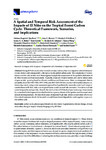A Spatial and Temporal Risk Assessment of the Impacts of El Niño on the Tropical Forest Carbon Cycle: Theoretical Framework, Scenarios, and Implications
| dc.contributor.author | Esquivel-Muelbert, | |
| dc.contributor.author | Bennett, | |
| dc.contributor.author | Sullivan, | |
| dc.contributor.author | Baker, | |
| dc.contributor.author | Gavish, | |
| dc.contributor.author | Johnson, | |
| dc.contributor.author | Wang, | |
| dc.contributor.author | Chambers-Ostler, | |
| dc.contributor.author | Giannichi, | |
| dc.contributor.author | Gomes, | |
| dc.contributor.author | Kalamandeen, | |
| dc.contributor.author | Pattnayak, | |
| dc.contributor.author | Fauset, S | |
| dc.date.accessioned | 2019-11-26T15:23:51Z | |
| dc.date.available | 2019-11-26T15:23:51Z | |
| dc.date.issued | 2019-09-27 | |
| dc.identifier.issn | 0004-6973 | |
| dc.identifier.issn | 2073-4433 | |
| dc.identifier.other | ARTN 588 | |
| dc.identifier.uri | http://hdl.handle.net/10026.1/15190 | |
| dc.description.abstract |
<jats:p>Strong El Niño events alter tropical climates and may lead to a negative carbon balance in tropical forests and consequently a disruption to the global carbon cycle. The complexity of tropical forests and the lack of data from these regions hamper the assessment of the spatial distribution of El Niño impacts on these ecosystems. Typically, maps of climate anomaly are used to detect areas of greater risk, ignoring baseline climate conditions and forest cover. Here, we integrated climate anomalies from the 1982–1983, 1997–1998, and 2015–2016 El Niño events with baseline climate and forest edge extent, using a risk assessment approach to hypothetically assess the spatial and temporal distributions of El Niño risk over tropical forests under several risk scenarios. The drivers of risk varied temporally and spatially. Overall, the relative risk of El Niño has been increasing driven mainly by intensified forest fragmentation that has led to a greater chance of fire ignition and increased mean annual air temperatures. We identified areas of repeated high risk, where conservation efforts and fire control measures should be focused to avoid future forest degradation and negative impacts on the carbon cycle.</jats:p> | |
| dc.format.extent | 588-588 | |
| dc.language | en | |
| dc.language.iso | en | |
| dc.publisher | MDPI AG | |
| dc.subject | carbon cycle | |
| dc.subject | physiological thresholds | |
| dc.subject | fire | |
| dc.subject | forest fragmentation | |
| dc.subject | climate change | |
| dc.subject | climate anomalies | |
| dc.subject | drought | |
| dc.subject | tropical forests | |
| dc.subject | biogeography | |
| dc.subject | El Nino | |
| dc.title | A Spatial and Temporal Risk Assessment of the Impacts of El Niño on the Tropical Forest Carbon Cycle: Theoretical Framework, Scenarios, and Implications | |
| dc.type | journal-article | |
| dc.type | Journal Article | |
| plymouth.author-url | https://www.webofscience.com/api/gateway?GWVersion=2&SrcApp=PARTNER_APP&SrcAuth=LinksAMR&KeyUT=WOS:000498267500026&DestLinkType=FullRecord&DestApp=ALL_WOS&UsrCustomerID=11bb513d99f797142bcfeffcc58ea008 | |
| plymouth.issue | 10 | |
| plymouth.volume | 10 | |
| plymouth.publication-status | Published online | |
| plymouth.journal | Atmosphere | |
| dc.identifier.doi | 10.3390/atmos10100588 | |
| plymouth.organisational-group | /Plymouth | |
| plymouth.organisational-group | /Plymouth/Faculty of Science and Engineering | |
| plymouth.organisational-group | /Plymouth/Faculty of Science and Engineering/School of Geography, Earth and Environmental Sciences | |
| plymouth.organisational-group | /Plymouth/REF 2021 Researchers by UoA | |
| plymouth.organisational-group | /Plymouth/REF 2021 Researchers by UoA/UoA06 Agriculture, Veterinary and Food Science | |
| plymouth.organisational-group | /Plymouth/Users by role | |
| plymouth.organisational-group | /Plymouth/Users by role/Academics | |
| dcterms.dateAccepted | 2019-09-24 | |
| dc.rights.embargodate | 2019-12-18 | |
| dc.identifier.eissn | 2073-4433 | |
| dc.rights.embargoperiod | Not known | |
| rioxxterms.versionofrecord | 10.3390/atmos10100588 | |
| rioxxterms.licenseref.uri | http://www.rioxx.net/licenses/all-rights-reserved | |
| rioxxterms.licenseref.startdate | 2019-09-27 | |
| rioxxterms.type | Journal Article/Review |


